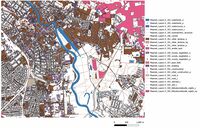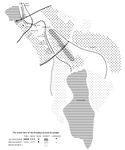Tartu WAVE Living Lab Team 3 2022
>>>back to working groups overview
Rationale
- Why do you think this case is relevant? What is your hypothesis considering the landscape challenges?
- Format: 3-4 sentences
Location and scope
You can edit this map with the map editor
Water as a natural system
Geomorphology, typologies and dynamics of water areas
- Describe the water areas of your area in the contxt of the wider water system
- How does water appear in the landscape of your living lab? What types of water areas are common?
- Please identify the water bodies' catchment areas, tributaries and floodplains
- Which dynamics do these water areas have?
- Have there been any flood events in the past?
- add 2-3 graphical representations to the image gallery, you can add more if you like
- try to use drawings that express the system dynamics
- Yourcase watersystem1.jpg
add a caption
- Yourcase watersystem2.jpg
add a caption
- Yourcase watersystem3.jpg
add a caption
Water as a living space
- Which habitats can be found in and along the water areas of your area?
- How is the water quality in your water areas?
- Which areas are still natural, which are urbanized/artificial?
- Your case green blue infrastructure1.jpg
add a caption
- Your case green blue infrastructure2.jpg
add a caption
Blue and Green Infrastructure
- What are the major potential elements of a green/blue infrastructure network? Are these likely to change/disappear? Why is that?
- You find my background material on green infrastructure in our reading list
- add 1-2 graphical representations to the image gallery, you can add more if you like
- Your case green blue infrastructure1.jpg
add a caption
- Your case green blue infrastructure2.jpg
add a caption
Water as a cultural space
Land use and water
Land uses along the Emajõgi
The Emajõgi banks are basically occupied for uses in settlement, greeneries, recreation, nature preservation, commercial and cultural services and some industrial activities. This diversity in the land use is not novel as Tartu was first established on the basis of water-provision for settlement purposes. First, the most vital area is Tartu’s cultural, historical and economical center which is established right next to the water course, expanding in three dimensions . With a ten-meter buffer around the river, no buildings exist immediately next to the river, except for harbors. Instead, roads and greenery is what adjoins the river, then comes the other land uses facilities; residential areas, commercial city center, educational buildings, industrial zone and big nature preservation site.
Evolution, status quo and driving forces for change
As Tartu is the European Capital of Culture 2024, most plans tend to maintain the cultural aspect of the city center. In turn, this is reflected on the river as it is a fundamental part of the cultural identity of the Tartuvians. First, more focus on promoting Urban Nature and maintaining the nature preservation area of Ihaste (Natura 2000). Second, there may be more investment in recreation on the river, especially with the increased number of foreigners residing in Tartu.
Cultural and spatial typologies of water areas
Evolution of spatial patterns
Since Tartu’s establishment, the use of the river’s banks evolved to be more diversity-inclusive. In the old days, residential areas were concentrated along the river with commercial activities represented in popular and formal markets. Also, religious centers existed there.
Nowadays, the residential areas have moved from being just next to the river as the river’s banks are more used for commercial and recreational uses. Some industrial activities were added in Ropkatööstuse. River now is protected with a buffer of greenery along its course.
The most novel usage of the area around the river is a new water body; Anne Kanal which was established during the Soviet times located between Annelinn and the Emajõgi.
Role of water areas within the overall urban morphology
Near the water areas concentrate most of the most vital cultural, commercial and administrative services, which makes them the focal point in development plans and services densification. Also, the recreational aspect of the river’s shore makes most of the touristic facilities concentrated near the river.
Sacred spaces and heritage
What represents the cultural value
With the factors of Tartu being the European Capital of Culture 2024 and Tartu being a “universities’ city”, the educational facilities have the greatest value as a part of the Tartuvian culture. The first educational buildings were established near the river. Also, Estonians, in general, highly respect forests, and this can be observed from the greenery near the river banks and the formal and informal efforts to maintain and develop the parks. Moreover, Old town, which is located in the city center, has a great value for Tartuvians, as this part still has its own old aspect, very well maintained, rehabilitated and reused.
- Your case sacredspace1.jpg
add a caption
- Your case sacredspace2.jpg
add a caption
- Your case sacredspace3.jpg
add a caption
Visual appearance and landscape narrative
People's perception towards the Emajõgi
People’s perception towards Emajõgi differs according to their purpose of using it; aesthetical, recreational or cultural usage. Other factors like seasons, time of the day and the overall atmosphere plays an important role too in this process. Their perception fluctuates to discern the river areas as paths, edges, nodes, districts and landmarks.
Art's perception towards the Emajõgi
In the old paintings, most artworks focus on picturing a bigger image of the river putting architecture in the front and focusing on documenting the architectural monument.
Then, when photography came, the focus changes to picture the daily life near the river; people selling fruits, others walking very-well dressed near the Arch Bridge, cars and busses and “traffic” with robust architecture in the background including all of these activities and people going a on trip in a small boat in the river. In such a case, the river was the hidden player.
Nowadays, Instagram shows that Emajõgi is perceived to be connected to elements like iconic architecture, water surface reflection, seasons, natural light and artificial light events, greeneries, recreational activities and pets.
- Index.php?title=File:Photoshots location.jpg
The most frequent spots, destinations and directions for taking photos on the Emajõgi banks(Ghieth Alkhateeb)
Water and People
Accessibility and usability
- Where are your water areas accessible, and where not? How strong are spatial obstacles preventing access?
- Who is using the spaces and how?
- Yourcase youraccessbilitymap.jpg
add a caption
- Yourcase usepatterns.jpg
add a caption
Community Mapping
What is to be mapped here?
- Social groups from within the community, for example the youth, kids, students, parents, the retired etc. Typically, these groups have specific needs, which you can also make explicit on the map. These people might not be organized in any way, but they are usually present in the context you are observing
- Local stakeholder groups: these groups are organized in one or the other way. They only exist within the community context you are observing. For example: the local community center, local churches, local interest groups, the landowners, small businesses and retailers
- External stakeholder groups are not necessarily present in the environment you are observing, but they may have strong stakes and interests. These can be local authorities, politicians, associations, care services etc.
- For each group, you may identify their needs, objectives, power and capacities
- You may also identify gaps and power conflicts
- Please try to redepict these elements in an integrated way and in relation to your water landscape. What is the relationship between these groups? Are they close or distanced from each other? Who is more powerful? Which voices are hardly heard? Do they have any shared concerns?
- Your case your community map1.jpg
add a caption
- Your case your community map2.jpg
add a caption
- Your case your community map3.jpg
add a caption
Possible Futures
- You can summarize your findings with a SWOT diagram and a DPSI(R) Model
- Link back to the Sustainable Development Goals: Which goals are at risk?
- What is your worst case scenario for this landscape?
- What is your best case scenario for this landscape?
- Present your scenarios in the form of a collage or sketch
- Add text and visuals
- Your case your spider diagram or dpsir model.jpg
explain your analysis briefly in the caption
- Your case yourworstcase visual.jpg
explain your worst case scenario briefly in the caption
- Your case yourbestcase visual.jpg
explain your best case scenario briefly in the caption
Collaborative Goal Setting
- Define strategic planning objectives based on the evaluation findings from your analysis
- Ideally, involve the community of your living labs into this process
- Link back to your original targets from section one and the Development Goals
- 150 words text contribution
Spatial Strategy and Transect
- translate your strategic goals into a vision
- develop a spatial translation of your vision
- exemplify your vision in the form of a transect with concrete interventions
- add map(s) and visualizations
- Your case spatial translaton vision.jpg
add caption here
- Your case transect.jpg
add caption here
- Your case transect detail1.jpg
add caption here
- Your case transect detail2.jpg
add caption here
From Theory of Change to Implementation
- For implementing your vision: Which partnerships are needed? Which governance model is required?
- Who needs to act and how? Draw and explain a change/process model/timeline
- Which resources are needed? On which assets can you build?
- add 150 words text and visuals
References
- give a full list of the references you have used for your case
Process Reflection
- Reflect in your intercultural and interdisciplinary team on the outcomes of your study
- Which limitations were you facing?
- What have you learnt from each other?
- What did you learn in the Living Labs?
- What would you do differently next time?
- You can also use diagrams/visuals
- 250 words text





